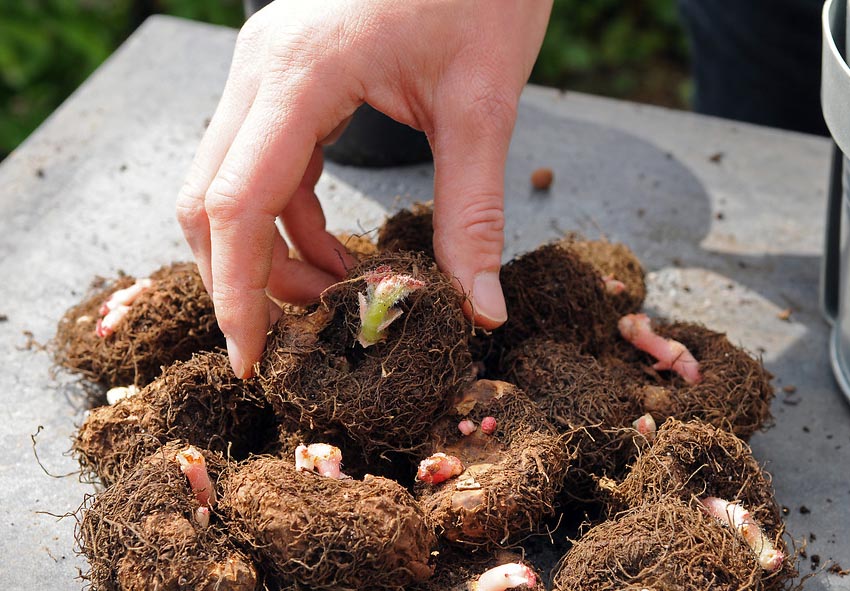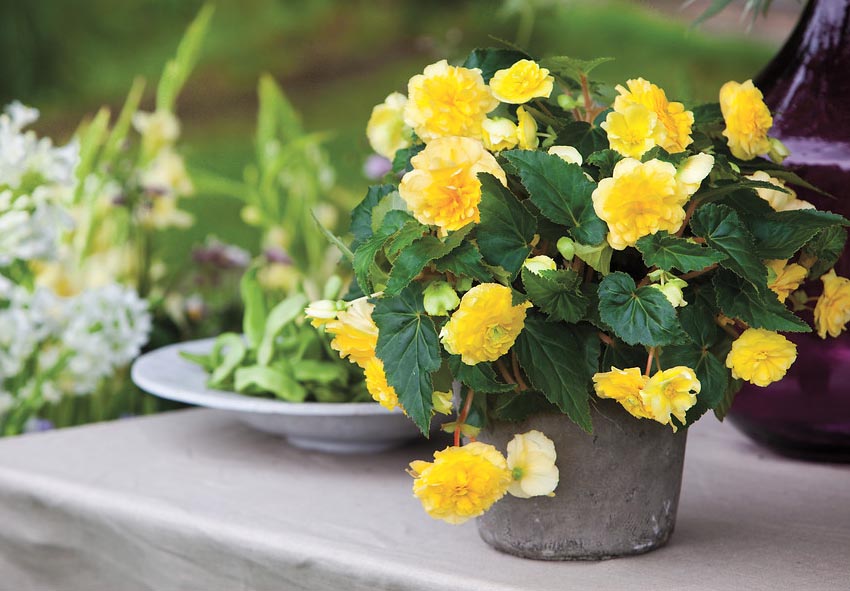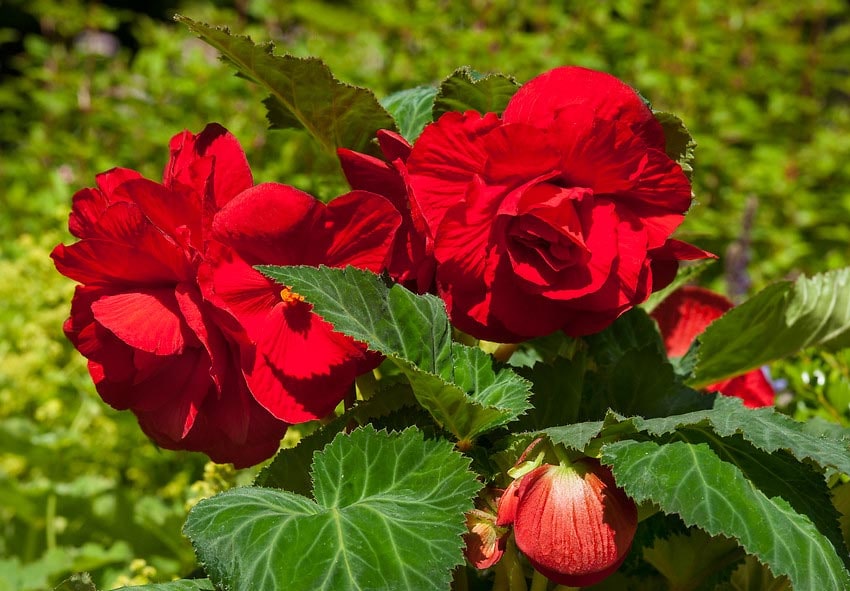Begonias are very decorative and easy to grow. These plants tolerate shade well and are ideal for gardens that rarely see the sun. The flower grows well in the garden but is also suitable for balconies and window sills with a northern orientation.
Growing begonias from seeds is not an easy task since the seeds of this plant are very small, like dust particles. And for the smallest sprout to turn into a gorgeous flowering plant, it needs to form a fairly large tuber. When grown from seeds, you can see the first flowers of tuberous begonia in the second year, and the most decorative plants are obtained from 3- to 4-year-old tubers that are 5-6 cm in diameter.
You can buy a begonia tuber and grow a beautiful flower on your own in the first year. If you decide to buy flowering begonias in a pot, be aware that many sellers sell tuberous begonias in pots from rooted cuttings and stimulate them to bloom more to attract buyers. Such plants spend all their energy on flowering. By autumn their tubers remain small and they do not have enough nutrients to overwinter and sprout in spring. Therefore, they often die.
What are Begonia Tubers?

Tuberous begonias are the result of selective breeding involving at least eight or nine plants previously grown in various areas around the world. Specialists began breeding work in the 19th century, and today, the results of such painstaking work are very impressive — more than 200 varieties of this perennial have been born.
Growing begonias from tubers is very convenient since begonias planting can be done both indoors and in the garden. There are ampelous, herbaceous, and dumetosous varieties of this flower. However, the crucial distinguishing feature is the presence of a developed root, which comes in the form of a massive tuber, reaching up to 6-7 centimetres in diameter.
When to plant begonia tubers? You can buy planting material for growing begonia tubers between late January and March. Carefully inspect the tuber of the variety you like. Choose begonia tubers that are at least 4 centimetres in diameter. To the touch, the tuber should be hard, heavy, without mould and wounds, and stored in slightly damp peat or sawdust.
The begonia tuber is hairy and dark brown in colour; its upper part is flat with small tubercles — these are the buds from which sprouts will appear. The lower part of the tuber is more rounded. When begonia tubers planting, it is crucial not to confuse the top and bottom. It is not worth buying a tuber with long sprouts, as they may break easily during transportation.
When to plant begonias tubers?
If you search “begonias when to plant” or “when to plant begonia corms,” you can find that a begonia grown from a tuber does not tolerate low-temperature conditions. Hence, begonias planting can be carried out in open ground only at above-zero temperatures in late spring or even early summer. Plants tend to grow more actively when planted in groups than when planted alone. If you decide to grow begonias at home, then your perennials will not be afraid of low temperatures, and the green foliage that appears will actively purify the air and heal it.
How to plant begonias?

There are some peculiarities of how to plant begonia tubers:
- Planting material can be purchased from a specialized nursery-garden or dug up in the autumn in the garden.
- All shoots must be removed from the tuber and placed in a container with soil, which is transferred to the basement with an air temperature of 8 to 10 degrees Celsius.
- In February, the tubers should be placed in moist soil, where they will germinate at temperatures up to 20 degrees, with good soil moisture and sufficient lighting.
- As soon as the buds of future shoots appear on the tuber, cut it into pieces with one shoot each and treat the cut points with coal powder and dry them, thereby preventing putrefactive diseases.
- Now plant the parts of the tuber with future shoots in containers with moist soil while deepening the tuber by no more than half. If small leaves have already appeared, then it is crucial to ensure that they do not come into contact with the soil. Otherwise, they may develop rot, causing the plant to die.
- Within 20 days, young shoots need to be looked after — moisten the soil and provide good lighting and heat. After this time, the plants can be transplanted to a permanent location for growth. At the same time, do not forget to add mineral dressing to the soil for better rooting and growth of begonias.
These are the main secrets on how to grow begonia tubers.
How to plant begonia corms?
When growing begonias from corms, you need to ensure that the soil is not waterlogged. Besides, it is crucial to choose the right pot size — it should not be too big or too small. It is enough that the new container is a couple of centimetres larger than the previous one. If you plant begonias in open ground, you need to choose a place where they will receive good and even lighting, as well as protection from drafts and strong winds.
Planting begonias in pots
How to plant begonia corms in hanging baskets and pots? Potted begonias sometimes resemble tiny roses and are therefore very popular. Caring for potted varieties is very similar to growing garden ones. The crucial thing is to provide shade. The flower grows well on northern window sills without sun. Tuberous species in the house can be grown year-round — they do not need a wintering period. The plant looks great in the back of the room — on the shelves or on a table. The plant needs fairly regular irrigation — it cannot be filled with water in a pot, but it does not like even temporary drying of the soil.
When do begonias flower?

How can you determine how much an indoor or garden begonia will bloom? Each variety of begonia has its own flowering period and time. Knowing the correct variety allows you to not only choose the conditions more appropriately but also determine when an indoor or garden begonia will bloom, when the plant is resting, and what it lacks.
If the gardener wants the begonia to continue to bloom at the end of the summer, the plant must be transplanted from the garden into a pot and brought indoors before the onset of cold weather. If the operation is successful, the plant will continue to bloom for the next two to three months.
Begonia care outdoors
For abundant flowering, begonias outdoors in the open ground require regular application of nutrient formulations. During the period of active growth, complex mineral compositions should be introduced. At the time of bud formation, potash and phosphorus fertilizers should be used.
Caring for begonias in the garden involves gently loosening the soil surface and regular watering. In October, for the winter period, the tubers must be removed from the flower bed with the upper part. It is recommended to cut the stems down to 3 centimetres.
Red also How and When to Plant Gladioli Bulbs.
Frequently Asked Questions (FAQs) about Planting Begonias From Corms or Tubers
1. What Are Begonia Corms and Tubers, and How Do They Differ?
Begonia corms and tubers are specialized underground storage structures that enable begonias to survive adverse conditions and regrow in the following growing season. Corms are short, thickened stems that store nutrients and produce shoots from their top. Tubers, on the other hand, are swollen root structures storing energy. The main difference lies in their appearance and the way they grow, but both can be used to propagate begonias.
2. When Is the Best Time to Plant Dutch Begonia Corms or Tubers?
The ideal time to plant begonia corms or tubers is in late winter or early spring, typically around February to April, depending on your climate zone. Planting during this period allows them to establish roots before the growing season begins. You can also start them indoors in late winter and transplant them outdoors when the risk of frost has passed. This timing ensures a strong start for your begonias.
3. What Are the Suitable Growing Conditions for Begonias From Corms or Tubers?
Begonias thrive in well-draining, slightly acidic soil with partial to dappled shade. Ensure the soil is rich in organic matter. Keep the soil consistently moist but not waterlogged, as begonias are susceptible to root rot. They prefer temperatures between 65°F and 75°F (18°C to 24°C). If you’re growing them indoors, provide bright, indirect sunlight or fluorescent grow lights.
4. Can I Order Begonia Corms or Tubers from Your Online Store?
Yes, you can order Begonia bulbs from our online store. We typically offer a variety of Begonia bulbs for purchase during the fall. Ordering in the fall allows you to receive your bulbs in time for spring planting, ensuring they have the best chance of thriving in your garden.
5. How Long Does It Take for Begonias to Bloom from Corms or Tubers?
The time it takes for begonias to bloom from corms or tubers varies depending on the species and growing conditions. Generally, you can expect to see blooms within 12 to 16 weeks after planting, assuming you’ve provided them with the right environment and care. Some varieties may bloom earlier, while others may take longer. Be patient, as begonias are known for their stunning and long-lasting flowers, which make the wait worthwhile.
Published: 08.03.2022
